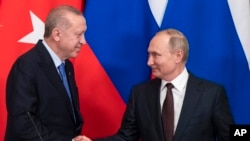A recent cease-fire deal brokered by Russia and Turkey in the northwestern Syrian province of Idlib seems to be largely holding.
No airstrikes and clashes between Russian-backed government forces and Turkish-backed rebel fighters have been reported since the truce went into effect on Friday, local news said.
The cease-fire came after Russian President Vladimir Putin and his Turkish counterpart Recep Tayyip Erdogan reached an agreement last week in Moscow to bring an end to a Syrian government offensive that had begun last year to recapture Idlib province, the last major rebel stronghold in the war-torn country.
As part of the agreement between the two leaders, Russian and Turkish forces will begin joint patrols on a key highway in Idlib.
"The next phase of the Russian-Turkish deal would be conducting joint patrols on the M4 highway,” said Rami Abdulrahman, director of the Syrian Observatory for Human Rights, a war monitoring group.
"The third phase would be the establishment for a safe zone under Turkish protection in Idlib,” he told VOA.
While the cease-fire agreement would largely halt the fighting in Idlib, Abdulrahman said, it could also allow Syrian government forces to keep territorial gains made during the recent offensive.
Previous deals
Some experts doubt that this deal would be different from previous agreements struck between Ankara and Moscow over Idlib, which had not been successful.
"This deal is fragile and shaky, and it doesn’t establish for permanent stability in the region,” said Ahmed Rahal, a former Syrian military general who is now a military analyst based in Britain.
"It is not clear whether this is a new protocol or merely an extension to previous deals reached between Russia and Turkey,” he told VOA.
In September 2018, Russia and Turkey reached an agreement that had postponed a planned Syrian regime offensive on Idlib and other areas near the Turkish border.
According to the agreement, Turkey was required to remove all extremist groups from the province, some of which are allied with the al-Qaida terror group.
But the deal proved unsuccessful as Ankara reportedly failed to implement its part of the deal, prompting Russian-backed Syrian President Bashar al-Assad’s forces to restart their military activities in Idlib.
As the humanitarian situation worsened in Idlib, which before the government offensive was home to nearly 3 million people, several other cease-fire agreements were reached but none were successful either.
The government offensive has led to hundreds s of thousands of civilians leaving the province to other parts of the country and to neighboring countries to escape violence.
Various extremist groups
Nicholas Heras, a Middle East expert at the Institute for the Study of War (ISW) in Washington, says the most important component of the new deal struck between Turkey and Russia is that Ankara is now formally responsible for reducing the power of al-Qaida-linked groups in Idlib, including Hayat Tahrir al-Sham (HTS).
Russian president “Putin has now formally put the task of confronting the powerful HTS onto Turkey as a condition for Russian maintenance of the cessation of hostilities in Idlib,” he told VOA, adding that Turkish president “Erdogan has moved significant Turkish military assets into Idlib, including tanks, artillery, and mechanized infantry units, that could be used to support a Turkish-backed Syrian rebel pressure campaign on HTS in Idlib.”
Heras, however, noted that Turkey’s willingness to challenge al-Qaida-linked groups in Idlib remains an open question.
"This is likely to be the biggest variable that will determine the scope and pace of a future Russian-backed Assad regime campaign on what is a shrinking Syrian rebel-held zone of control in Idlib,” he said.
In addition to HTS, the largest Islamist group in Idlib – which previously was al-Qaida’s branch in Syria – there are other extremist factions that are active in the northwestern province.
Huras al-Din and the Turkistan Islamic Party in Syria are two other extremist groups that have maintained a significant presence in parts of Idlib.
Western intelligence agencies believe that thousands of foreign fighters affiliated with different radical groups are active in Idlib.
Humanitarian crisis
Rights groups say that over one million civilians have been displaced due to the recent Russian-backed Syrian offensive on Idlib.
According to the U.N. humanitarian affairs coordination office, more than half a million children are among those displaced.
U.N. officials say the recent fighting has aggravated a dire situation in northwest Syria, where 2.8 out of 4 million people were already estimated to be in need of humanitarian assistance.
Analysts and residents in Idlib expressed fears that the latest cease-fire would not be entirely meaningful as long as the ongoing humanitarian crisis is not addressed.
"The cease-fire deal talks about the return of refugees to Idlib, but under what circumstances? People refuse to go back to any area under the control of Syrian regime forces,” analyst Rahal said.
"What makes people uneasy about the cease-fire is that Russia continues to say that Assad forces must reassert their full control over the entire country,” he added.
Mahmoud Najjar, a 32-year-old Idlib resident who now lives in a displacement camp, says even if the cease-fire holds for a long time he would not consider returning to his home.
"Previous experiences have taught us not to trust the Syrian regime and its Russian ally,” he told VOA.









